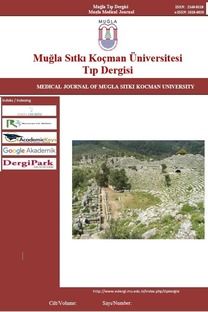Türkiye'de Bir Üniversite Hastanesi Dermatoloji Kliniğine Başvuran Vitiligo Hastalarının Klinik Bulguları
Stres, Tiroid otoantikorları, Vitiligo
Clinical Findings of Vitiligo Patients Attending a University Hospital Dermatology Clinic in Turkey
Stress, Thyroid autoantibodies, Vitiligo,
___
- Tarle RG, Nascimento LM, Mira MT, Castro CC. Vitiligo--part 1. An Bras Dermatol. 2014;89(3):461-70.
- Behl PN, Bhatia RK. 400 cases of vitiligo. A clinico-therapeutic analysis. Indian J Dermatol. 1972;17(2):51-6.
- Ezzedine K, Lim HW, Suzuki T, et al. Revised classification/nomenclature of vitiligo and related issues: the Vitiligo Global Issues Consensus Conference. Pigment Cell Melanoma Res. 2012;25(3):E1-13.
- Pradhan V, Patwardhan M, Thakkar V, et al. Vitiligo patients from India (Mumbai) show differences in clinical, demographic and autoantibody profiles compared to patients in western countries. J Eur Acad Dermatol Venereol. 2013;27(3):279-86.
- Gonul M, Cakmak SK, Oguz D, Gul U, Kilic S. Profile of vitiligo patients attending a training and research hospital in Central Anatolia: a retrospective study. J Dermatol. 2012;39(2):156-9.
- Hadler RM, Taliaferro SJ. Vitiligo In: Wolff K, Goldsmith L, Katz S, Gilchrest B, Paller A, Leffell D, editors. Fitzpatrick’s Dermatology in General Medicine 7th ed. New York: McGraw-Hill; 2008. p. 616-22.
- Ongenae K, Van Geel N, Naeyaert JM. Evidence for an autoimmune pathogenesis of vitiligo. Pigment Cell Res. 2003;16(2):90-100.
- Mohammed GF, Gomaa AH, Al-Dhubaibi MS. Highlights in pathogenesis of vitiligo. World J Clin Cases. 2015;3(3):221-30.
- Gill L, Zarbo A, Isedeh P, Jacobsen G, Lim HW, Hamzavi I. Comorbid autoimmune diseases in patients with vitiligo: A cross-sectional study. J Am Acad Dermatol. 2016;74(2):295-302.
- Akay BN, Bozkir M, Anadolu Y, Gullu S. Epidemiology of vitiligo, associated autoimmune diseases and audiological abnormalities: Ankara study of 80 patients in Turkey. J Eur Acad Dermatol Venereol. 2010;24(10):1144-50.
- Ezzedine K, Gauthier Y, Leaute-Labreze C, et al. Segmental vitiligo associated with generalized vitiligo (mixed vitiligo): a retrospective case series of 19 patients. J Am Acad Dermatol. 2011;65(5):965-71.
- Taieb A, Picardo M. Clinical practice. Vitiligo. N Engl J Med. 2009;360(2):160-9.
- Boisseau-Garsaud AM, Garsaud P, Cales-Quist D, Helenon R, Queneherve C, Claire RC. Epidemiology of vitiligo in the French West Indies (Isle of Martinique). Int J Dermatol. 2000;39(1):18-20.
- Onunu AN, Kubeyinje EP. Vitiligo in the Nigerian African: a study of 351 patients in Benin City, Nigeria. Int J Dermatol. 2003;42(10):800-2.
- Topal IO, Duman H, Gungor S, Kocaturk E, Kuteyla Can P. Evaluation of the Clinical and Sociodemographic Features of Turkish Patients with Vitiligo. Acta Dermatovenerol Croat. 2016;24(2):124-9.
- Zhang Z, Xu SX, Zhang FY, et al. The analysis of genetics and associated autoimmune diseases in Chinese vitiligo patients. Arch Dermatol Res. 2009;301(2):167-73.
- Yoshida A, Takagi A, Ikejima A, Takenaka H, Fukai T, Ikeda S. A retrospective study of 231 Japanese vitiligo patients with special reference to phototherapy. Acta Dermatovenerol Croat. 2014;22(1):13-8.
- Akrem J, Baroudi A, Aichi T, Houch F, Hamdaoui MH. Profile of vitiligo in the south of Tunisia. Int J Dermatol. 2008;47(7):670-4.
- Onarslan G, Ersoy L. Immunoperoxidase method for investigation of presence Ig G and C3 in vitiligo patients. Turkderm. 1991;25:97-102.
- Singh M, Singh G, Kanwar AJ, Belhaj MS. Clinical pattern of vitiligo in Libya. Int J Dermatol. 1985;24(4):233-5.
- Viana MC, Andrade LH. Lifetime Prevalence, age and gender distribution and age-of-onset of psychiatric disorders in the Sao Paulo Metropolitan Area, Brazil: results from the Sao Paulo Megacity Mental Health Survey. Braz J Psychiatry.2012;34(3):249-60.
- ISSN: 2148-8118
- Yayın Aralığı: Yılda 3 Sayı
- Başlangıç: 2014
- Yayıncı: Muğla Sıtkı Koçman Üniversitesi
Anterolateral Ligamanın Anatomik, Biyomekanik ve Radyolojik Özellikleri
Betül YÜRÜRDURMAZ, ÜMİT ÜNÜVAR GÖÇEOĞLU, Muazzez Elçin KIYMET, YASEMİN BALCI
Temporal Bölge Üzerindeki Cilde Metastaz Yapan Renal Hücreli Karsinom: Nadir Bir Klinik Sunum
Şükrü KASAP, Havva ÖZŞEKER, Özgür TANRIVERDİ, Mustafa NİŞANCI
Endoskopik Endonazal Yol ile İntraorbital Dermoid Kist Eksizyonu
Yüce İSLAMOĞLU, Yağmur CANAN, Gülin Gökçen KESİCİ, MEHMET ALİ BABADEMEZ
Akut İskemik İnmeli Olgularda Troponin Düzeyleri ve Elektrokardiyografik Değişikliklerin İncelenmesi
Sinan YILDIRIM, Mehmet Tayfun KAŞIKCI
Romatoid Artritli Bir Hastada Multipl Risk Faktörleri Sebebiyle Oluşan Genç İnme: Olgu Sunumu
Berke ARAS, Volkan YILMAZ, Fatma AVŞAR ERTÜRK
Migren ve Gerilim Tipi Baş Ağrılı Hastalarda Yeme Bozuklukları Prevalansı
R. Gökçen GÖZÜBATIK ÇELİK, Onur BİLGİÇ, Burcu GÖKSAN YAVUZ, Baki GÖKSAN, Muazzez Gökçen KARAHAN, Ozan ALTIN
Laparoskopik Sleeve Gastrektomide Farklı Enerji Cihazlarının Postoperatif Komplikasyonlara Etkisi
